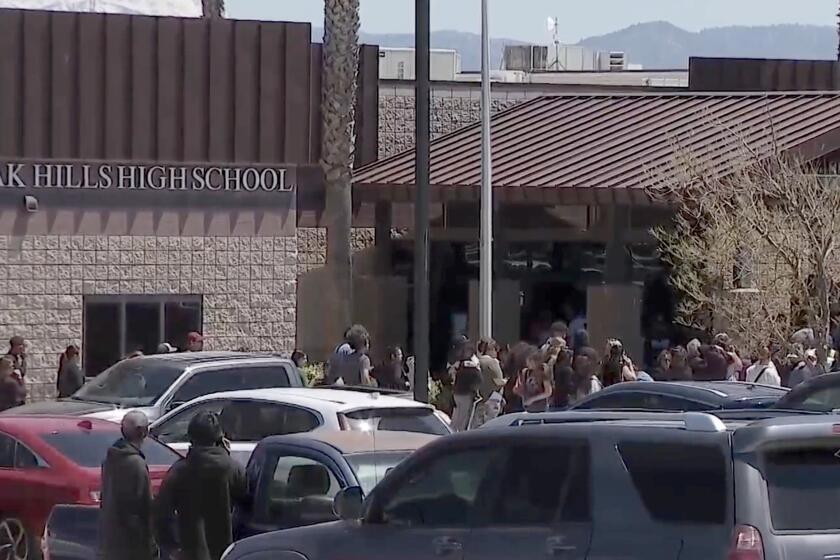California murderer’s execution OKd
A federal judge on Friday cleared the way for the first execution in California in nearly five years when he refused to halt murderer-rapist Albert Greenwood Brown’s death by lethal injection, scheduled for Wednesday.
U.S. District Judge Jeremy Fogel expressed concern about the limited time he had to evaluate the state’s newly revised execution procedures and gave Brown the choice of being put to death by a single injection, as practiced in Washington and Ohio, instead of by the state’s three-drug method.
Fogel expressed inner conflict over his ruling, saying his court was “painfully aware that however it decides a case of this nature, there will be many who disagree profoundly with its decision. The moral and political debate about capital punishment will continue, as it should.”
But the state has “a strong interest in proceeding with its judgment,” the judge conceded. He said he was offering the single-injection option to alleviate his residual concerns about the potential for the three-injection method to subject condemned inmates to cruel and unusual punishment.
In as many as seven of the previous 11 lethal-injection deaths carried out at San Quentin State Prison, there were reports that the prisoner might not have been fully anesthetized by the first injection, the powerful barbiturate sodium thiopental, Fogel noted in his ruling.
“The fact that nine single-drug executions have been carried out in Ohio and Washington without any apparent difficulty is undisputed and significant,” Fogel said, giving Brown that option.
Fogel had asked the California Department of Corrections and Rehabilitation earlier this week whether it could use the single-injection method. Attorneys for the state told Fogel the corrections staff needed only three days to retrain the execution team for the one-drug method, in which a much larger dose of the barbiturate would put the prisoner into a deep sleep as his organs shut down.
One of Brown’s attorneys, John R. Grele, said the legal team was weighing its options and might appeal to the U.S. 9th Circuit Court of Appeals. The motions panel for September consists of three judges appointed to the court by former President George W. Bush.
On Monday, Brown’s lawyers are expected to argue before a Marin County court that the state did not follow mandatory procedures when it went about drafting the new lethal-injection policy to address deficiencies identified by Fogel when he effectively stayed executions with a ruling in 2006.
Santa Clara University law professor Ellen Kreitzberg, an expert on the death penalty, said Friday’s ruling surprised her.
Five years ago, she said, Fogel spent a lot of time meticulously examining the setting, training and testing that lay behind California’s lethal injection process before finding flaws in it. But the judge’s ruling in Brown’s case came without his having examined the new execution chamber that has been built in the meantime and without his examining the training for those who administer the drugs.
“There are so many unanswered questions and so many uncertainties that to allow the execution to go forward with those is really troubling,” said Kreitzberg, who opposes the death penalty. “It’s surprising after five years that everyone is rushing to have these executions move forward so quickly.”
Brown had petitioned Fogel’s court last week to join the case brought by fellow death row inmate Michael Morales, who had challenged the state’s former lethal-injection procedures as violating the Constitution’s prohibition of cruel and unusual punishment.
Attorneys for the state objected, claiming the procedures challenged by Morales are no longer in use. They were replaced by new protocols approved by a state agency in late July.
After halting Morales’ execution in February 2006, Fogel held hearings that led to his ruling that the former execution methods risked exposing prisoners to unconstitutional levels of pain.
Among the deficiencies Fogel identified were insufficient training of the execution team and cramped conditions and poor lighting in the gas chamber that was then in use for lethal-injection executions. Two other prisoners were executed by lethal gas in the early 1990s, bringing to 13 the number put to death by the state since capital punishment was reinstated in 1976.
Corrections officials in 2007 built a new Lethal Injection Chamber — four times larger than the gas chamber — and unveiled the facility on Tuesday.
There are 708 prisoners on California’s death row, but only a few have exhausted all appeals and are eligible to be issued death warrants.
Brown, 56, was convicted of the aggravated murder of Arlington High School student Susan Jordan in 1980 in Riverside. The 15-year-old was walking to school when Brown pulled her into an orange grove, raped her and strangled her with her shoelaces. He called the girl’s parents and told them where to find her body.
Brown had been paroled four months earlier from a prison term imposed for the 1977 rape of a 14-year-old girl.
A Riverside County judge last month ordered Brown’s execution for Wednesday.
John Hall, a spokesman for the Riverside County district attorney’s office, said prosecutors were pleased with Fogel’s ruling.
“This is a horrific case with horrific facts,” Hall said. “This man showed no remorse. He never claimed innocence.... It’s time for this family to finally see justice. It’s been delayed too long already.”
Some advocacy groups hailed Fogel’s decision.
“Today’s ruling marks the end of the injustice in this case, and we may be near the end in many others, where the sentences have been delayed for reasons that have nothing to do with the guilt of the murderers or the fairness of their trials,” said Kent Scheidegger, legal director for the Criminal Justice Legal Foundation in Sacramento.
Times staff writer Jack Leonard contributed to this report.
More to Read
Start your day right
Sign up for Essential California for news, features and recommendations from the L.A. Times and beyond in your inbox six days a week.
You may occasionally receive promotional content from the Los Angeles Times.







